John G. Roberts Jr. ’76, J.D. ’79, has written hundreds of Supreme Court opinions in his 20 years as chief justice of the United States. The most important, to the nation and to his legacy, may be his opinion in Trump v. United States, which changed the balance of power among the branches of government—and rewrote the meaning of the Constitution.
A federal grand jury had indicted former President Donald Trump for his actions after the November 2020 election, charging him with, among other lawbreaking, using “dishonesty, fraud, and deceit” to prevent the peaceful transfer of power. Trump moved to dismiss the charges, arguing that he should have absolute immunity from criminal prosecution for actions he had performed while carrying out his official duties.
In July 2024, by a 6-3 vote, the Supreme Court overruled federal trial and appeals courts to decide in Trump’s favor. The Roberts opinion broadly expanded the authority of the presidency by saying that a former president is immune from prosecution, even after his tenure, for official acts he took under his exclusive authority as president. And he is likely immune, the Court ruled, for all other official acts he took while in office—as the opinion put it, even in “the outer perimeter” of his responsibilities. The opinion’s foundational idea is that “unlike anyone else, the president is a branch of government, and the Constitution vests in him sweeping powers and duties.”
Over 41 pages, Roberts made his reasoning clear: the “pall of potential prosecution” poses a danger to the presidency and the nation if it prompts a president to hesitate to execute his duties “fearlessly and fairly.” Roberts emphasized that he was separating Trump’s actions from the privileges of the office. “We must not confuse ‘the issue of a power’s validity with the cause it is invoked to promote,’” he wrote, “but must instead focus on the ‘enduring consequences upon the balanced power structure of our Republic.’”
The decision was about the prerogatives of the presidency, rather than an absolution of Trump’s conduct during his first term as president or an endorsement of his cause. But it was the fullest expression the Court has ever made of a maximalist view of that power, narrowly checked by the Court and Congress.
Its legal consequences are extreme. The Constitution sets out a deliberate order in its articles establishing the branches of power: I for Congress, II for the executive. The Court’s ruling all but reverses the importance of those branches and retracts a critical power of the judiciary that limited wrongdoing by a president.
Roberts, often described as an institutionalist, has enabled the most hostile anti-institutionalist ever elected president.
In her dissent in the case, Justice Sonia Sotomayor, joined by Justices Elena Kagan, J.D. ’86, and Ketanji Brown Jackson ’92, J.D. ’96, warned about the consequences of such a broad expansion of presidential power. “The Court effectively creates a law-free zone around the President,” upsetting the status quo that had existed since the nation’s founding and giving blanket permission for wrongdoing, Sotomayor wrote. “Let the President violate the law, let him exploit the trappings of his office for personal gain, let him use his official power for evil ends,” she summarized. “In every use of official power, the President is now a king above the law.”
Roberts remarked in his opinion that the “tone of chilling doom” in her dissent was “wholly disproportionate” to what the ruling meant. But Sotomayor’s words proved prescient: the breadth of power that President Trump and his administration have asserted in the months since he was sworn in for his second term has made plain how boundlessly they interpret the reach of the presidency.
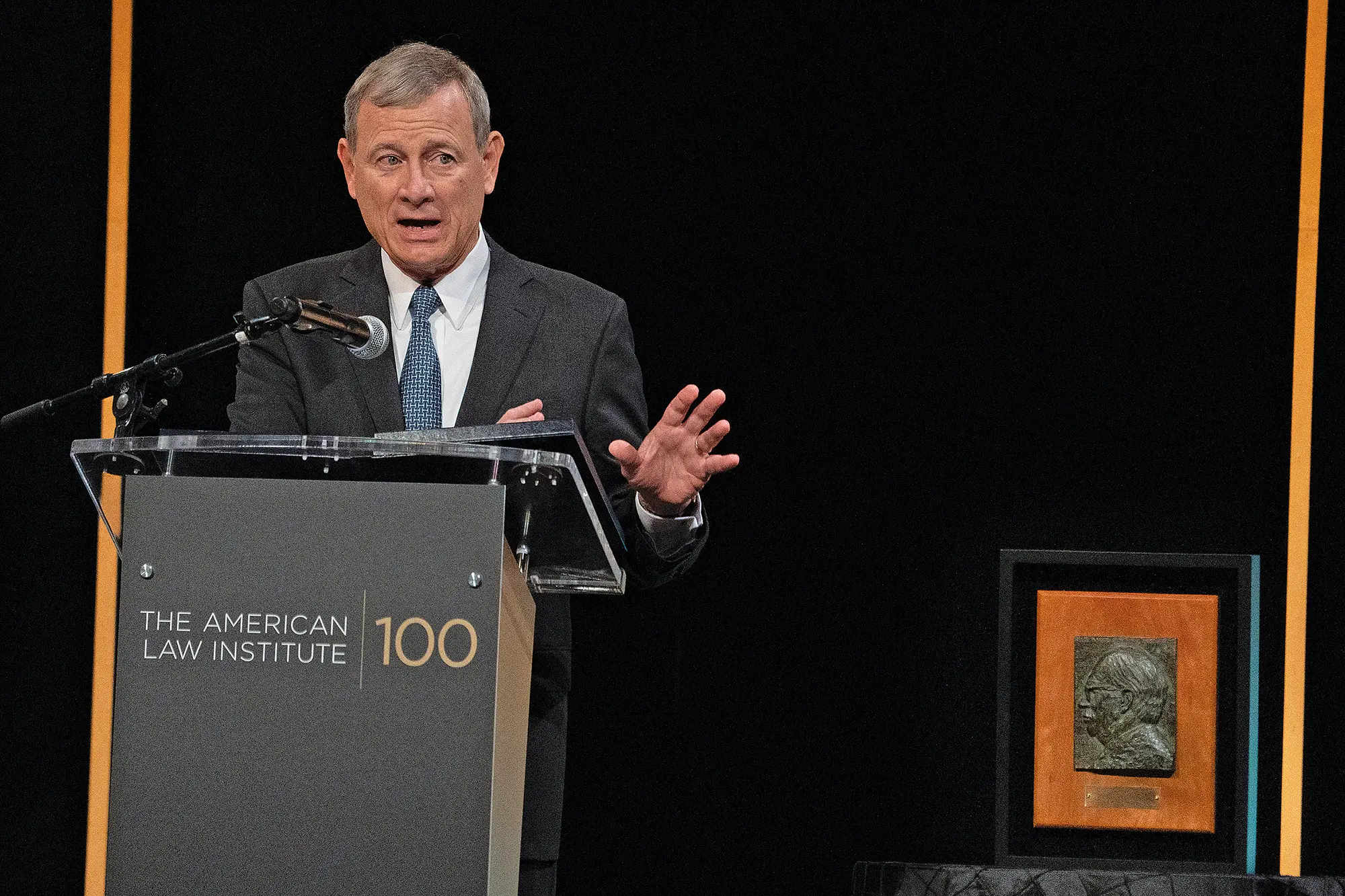
As the legal scholar Peter Shane ’74 wrote in The Atlantic in July, Roberts’s opinion didn’t anticipate Trump acting in any of those ways—even though Trump, running again for the presidency at the time of the ruling, was making promises to his supporters of precisely what he would do with barely limited power. But Shane’s criticism was also much graver. “No one on the Supreme Court has gone further to enable Trump’s extreme exercise of presidential power than the chief justice of the United States, John Roberts,” he declared. “What America is witnessing is a remaking of the American presidency into something closer to a dictatorship.”
He went on: “Trump’s use of executive power is not a distortion of the Roberts Court’s theory of the presidency; it is the Court’s theory of the presidency, come to life.”
The Trump opinion underscores the sometimes-contradictory nature of Roberts’s record as chief. At 70, he is an exceptionally capable and strong-willed justice who takes pride in the independence of his judgment and in his tie to the eminent, nonpartisan tradition of seeking “the right result for the right reasons.” Yet he is also the product of a long-building, now-dominant conservative legal movement whose triumphs are widespread, with effects that are still unfolding.
In some corners of public opinion and judicial analysis, the Trump ruling cemented Roberts’s reputation as a Republican and conservative partisan. It also cemented a view of the Court as a tool for carrying out Trump’s anti-democracy agenda—the opposite of what Roberts sought in his opinion.
Now, the Trump ruling looms over cases that are likely to, or scheduled to, come before the Court in coming months, including at least two involving the government’s attempts to punish Harvard for perceived political excesses—which Harvard argues are a direct violation of its First Amendment rights. Other cases seem similarly fateful, about the authority of Congress, the independence of federal agencies, the use of the military in policing civilian life, and the nature of American citizenship.
Their outcomes, along with the Court’s actions in the last few years, carry the seeds of American tragedy. Roberts, often described as an institutionalist, has enabled the most hostile anti-institutionalist ever elected president. The leader of the nation’s judicial system has empowered the president who is the most disdainful in history of the decrees of judges, the provisos of the Constitution, and the workings of American democracy. The chief justice, attempting to thread the needle between principle and practicality, has opened the door to the possibility of the ultimate constitutional crisis: a president’s outright defiance of the Supreme Court.
* * *
In 2023, a year before the Court issued the Trump decision, Roberts received the Henry J. Friendly Medal, a prestigious award honoring his achievement in law, from a research organization of the bar’s elite called the American Law Institute. The award is named for Judge Henry Friendly, A.B. 1923, LL.B. ’27, LL.D. ’71, who served on the U.S. Court of Appeals for the Second Circuit for 27 years and is considered one of America’s great twentieth-century judges.
Roberts was a Friendly law clerk for a year starting in 1979, when Roberts was 24 and Friendly was 75. He was a favorite of Friendly’s among his many clerks over the years, and the feeling was mutual. Accepting the award, Roberts explained how important the judge remained as a model for him in many ways—even disclosing that the robe Friendly wore on the Second Circuit hangs in his closet in the Supreme Court robing room. As Friendly did, Roberts writes his judicial opinions by hand.
“I saw, on a day-to-day basis, an eye-to-eye basis, that a good and full life could be led in the law.”
— John Roberts at the Friendly Medal award ceremony in 2023
Roberts recounted that, when he finished Harvard Law School, he questioned his choice of career, concerned that “the law was a rather cynical profession.” But, he went on, “a year with Henry Friendly changed everything. I saw, on a day-to-day basis, an eye-to-eye basis, that a good and full life could be led in the law.”
Roberts cited “three significant aspects” of Friendly’s approach to judging as the touchstones of his own. The first is an open mind, not beholden to any school of legal thought (“He delighted in fitting a particular case in the context of the law as a whole”). The second is a belief in the power of reason, with the steps of legal logic laid out (“There’s no hiding the ball”). The third is a pragmatic concern about human, social, and legal consequences. That was how the chief justice saw his own work. That was how he wanted it to be seen. That was also how some of his colleagues on the Court hoped he would craft his opinions.
At the Friendly Medal award ceremony, Justice Kagan, who served as dean of Harvard Law School from 2003 to 2009, introduced the chief justice before he spoke. While noting, and joking, that their votes in many cases have been for clashing sides, she validated Roberts’s dedication to the law and his good faith in carrying out his duties on the Court. An acclaimed writer herself, she called his prose “the best writing in law.”
Roberts’s opinions, Kagan said, are transparent about their reasoning and clear enough to be a useful guide for future conduct. And, pointedly, she noted that his opinions “encourage, even if they don’t guarantee, law that in its substance is careful and restrained and principled”—respectful, she implied, of precedent and of laws passed by elected bodies such as Congress; reluctant to reject settled rules and norms; and moderate as a matter of conviction, because that contributes to law’s stability and to maintaining the people’s trust.
She seemed to be working the ref—encouraging Roberts to follow the model of the moderate, legal process-oriented Friendly rather than the very conservative, states’ rights-oriented, sometimes anti-civil-rights William Rehnquist, for whom Roberts went on to clerk at the Supreme Court.
Roberts’s record shows the influence of both philosophies—as well as tenacity and intense ambition. From his youth, Roberts stood out as an achiever, a teenage National Merit Scholar and the first person from his private, Catholic Indiana high school to attend Harvard. He graduated summa cum laude and Phi Beta Kappa from Harvard College in three years. An essay he wrote about the lawyer, senator, and orator Daniel Webster, called “The Utopian Conservative,” won a Bowdoin Prize for literary merit.
Roberts was the managing editor of the Harvard Law Review, chosen by its liberal president for his talent, diligence, and integrity. He graduated magna cum laude from Harvard Law School. In The Chief, her 2019 biography of Roberts, the legal journalist Joan Biskupic describes him as an introvert who worked himself to exhaustion through college and law school and learned how to present himself with charm and humility, grace and polish.
After excelling for Friendly, Roberts did a stellar job at the Supreme Court for then-Justice, later Chief Justice Rehnquist—who was known in that period as the Lone Ranger because he sometimes wrote hardline conservative dissents that no other justice joined. Then, when President Ronald Reagan gave his inaugural address in January 1981—declaring that “it is time for us to realize that we’re too great a nation to limit ourselves to small dreams”—Roberts heard a “call to action” (his words), Biskupic reported, “to join the ideological battle” (hers).
At 26, Roberts became a special assistant to the attorney general in the Reagan administration—and soon became known in the Department of Justice as one of the New Right’s steeliest and most combative and effective members. He was recruited to the White House counsel’s office where, for four years, he carried out the movement’s work targeting the liberalism of the Supreme Court, and especially its decisions fulfilling the purposes of the post-Civil War constitutional amendments.
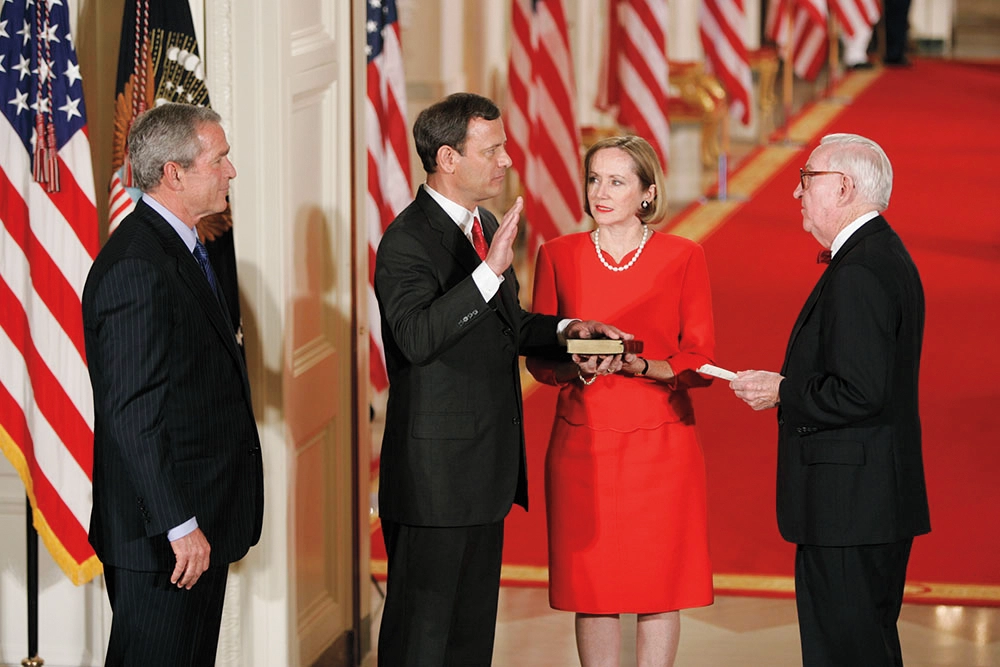
| Photograph related to the George W. Bush administration as part of the records of the White House photo office collection
Where liberals on the Court saw a drive to include all people, especially of color, in the full sweep of American opportunity and the law’s protection—by upholding civil rights laws and improving fairness in law enforcement and other legal areas—conservatives saw judicial activism that strayed from the Constitution’s original intent. In 1985, in a speech at the American Enterprise Institute, Reagan’s second attorney general, Edwin Meese III, decried an “aggressively secular liberalism often driven by an expansively egalitarian impulse.” He went on, “The result has been nothing less than an abandonment of many of the traditional political and social values the great majority of Americans embrace.”
The movement sought to create a new conservative regime in law: elevating the power of the Republican presidency; reducing deference to laws made by the Democrat-dominated Congress; and packing the federal courts with conservative judges who would reach conservative results. The most prized combatants were lawyers with superb credentials, like Roberts, whose lawyerly personalities helped them thrive and succeed in the politics of the movement and more widely.
In 1986, Roberts went to work for the Washington, D.C., law firm of Hogan & Hartson (now Hogan Lovells) and was named a partner after a year. In 1992, when Roberts was 37, President George H.W. Bush nominated him to the U.S. Court of Appeals for the District of Columbia Circuit, but the Democratic majority in the Senate blocked his confirmation vote. President George W. Bush nominated him a second time to the D.C. Circuit: he joined that court in 2003. Two years later, to Roberts’s surprise, the president nominated him to replace Justice Sandra Day O’Connor.
Roberts had expected a woman would be nominated to replace the first woman ever to serve on the Supreme Court, so he felt relaxed during his interview with Bush—which might explain a surprising observation of the president about a man known for being, among other things, steely and combative. In his memoir, Bush wrote: “Behind the sparkling resume was a genuine man with a gentle soul.”
Chief Justice Rehnquist died six and a half weeks after Bush nominated Roberts for the O’Connor seat. Two days after Rehnquist’s death, the president nominated him to be chief. (Bush chose Samuel A. Alito Jr. to fill O’Connor’s seat.)
Roberts was confirmed by the Senate 78-22. He was 50 years old: the youngest chief justice since his hero and role model of two centuries before, John Marshall. In his confirmation hearings, the most memorable speech came from Illinois Senator Barack Obama, J.D. ’91, a former president of the Harvard Law Review, three years before he was elected president of the United States. It expressed standard partisan opposition to a judicial nominee—Supreme Court confirmation votes after that largely split along party lines—but it also contained a more cutting legal and political critique.
“There is absolutely no doubt in my mind Judge Roberts is qualified to sit on the highest court in the land,” Obama made clear. “The problem I had is that when I examined Judge Roberts’s record and history of public service, it is my personal estimation that he has far more often used his formidable skills on behalf of the strong in opposition to the weak.” He concluded, “The bottom line is this: I will be voting against John Roberts’s nomination. I do so with considerable reticence. I hope that I am wrong.”
* * *
The journalist Matthew Continetti, writing in The Weekly Standard in 2005, noted about Roberts’s prize-winning essay on Daniel Webster that, as a college student, Roberts was drawn to Webster’s “ability to engage in politics while behaving as if he were above politics.” As chief, Roberts has done something strikingly similar. The centerpiece of his Senate confirmation testimony was about his view that the work of the Court is not political:
Judges are not politicians who can promise to do certain things in exchange for votes…I will decide every case based on the record, according to the rule of law, without fear or favor, to the best of my ability, and I will remember that it’s my job to call balls and strikes, and not to pitch or bat.
But as the legal scholar Neil Siegel told me, “Whether it’s John Marshall or John Roberts, when justices say, ‘We do law, not politics,’ they are acting politically, not legally.” In an article scheduled to come out next spring in the Harvard Law Review, Siegel and the legal scholar Curtis Bradley, J.D. ’88, call that type of move “judicial self-protection.” They say that Supreme Court justices have engaged in it to maintain influence in the political world when they have faced political threats from the executive, the states, or Congress. The Court must persuade powerful politicians to abide by its decisions and, in the case of the president, enforce them. “In short,” they write, “the Court has two central tasks, especially when it is under threat: preserving the Constitution and the rule of law; and protecting itself.”
Roberts has angered conservatives and surprised liberals with occasional opinions and votes that were forms of judicial self-protection. The best-known came in 2012, with the Court’s long-anticipated ruling on the Affordable Care Act, a prime achievement of the Obama administration that had narrowly passed Congress with no Republican support. Roberts voted with four liberals on the Court to uphold the law, on the grounds that its “individual mandate,” compelling people to purchase health insurance, could be characterized as a tax. But he also joined the Court’s four other conservative justices in striking down the use of the Commerce Clause to justify such mandates—an outcome liberals condemned as a needless curtailment of congressional authority.
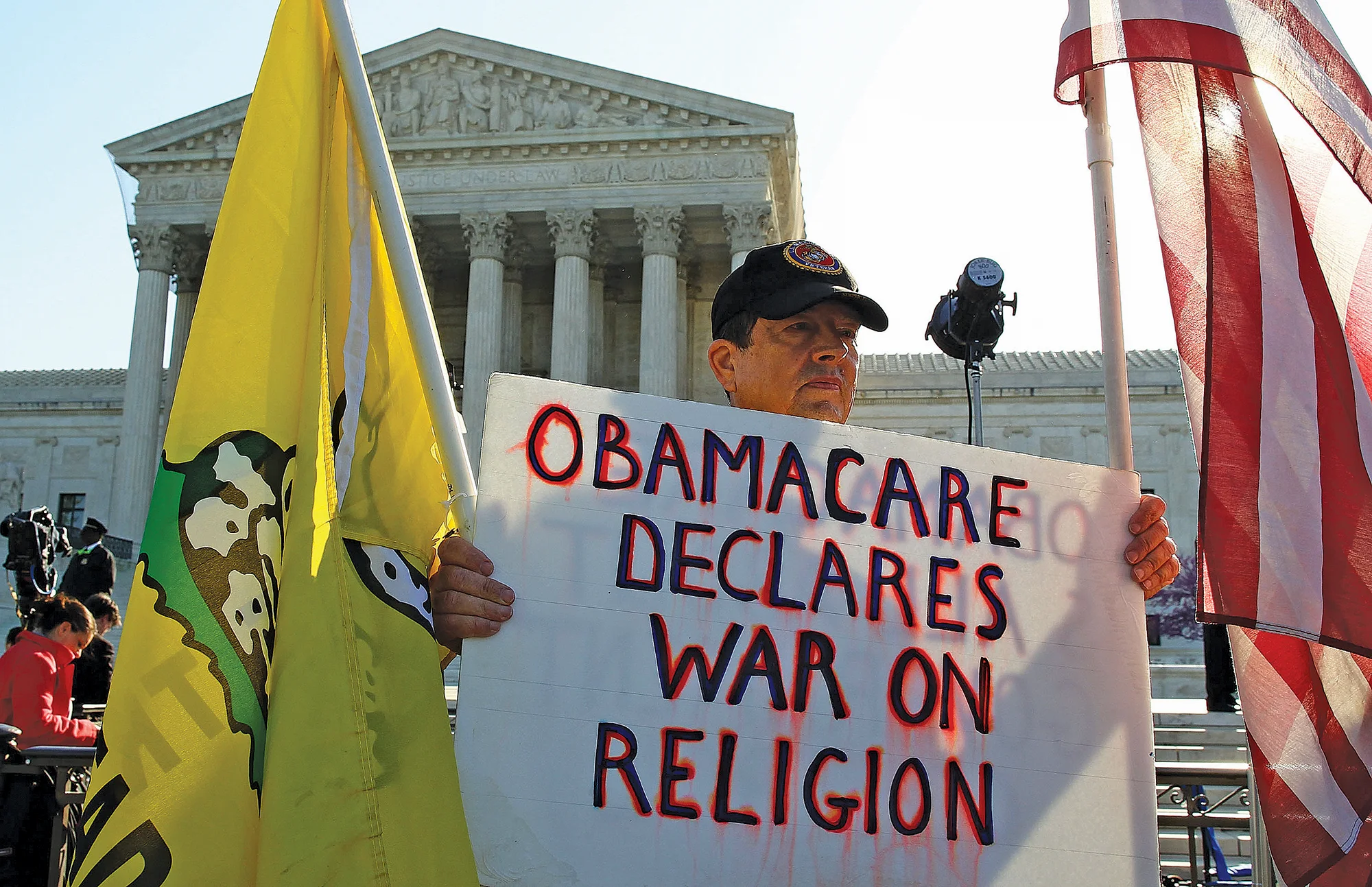
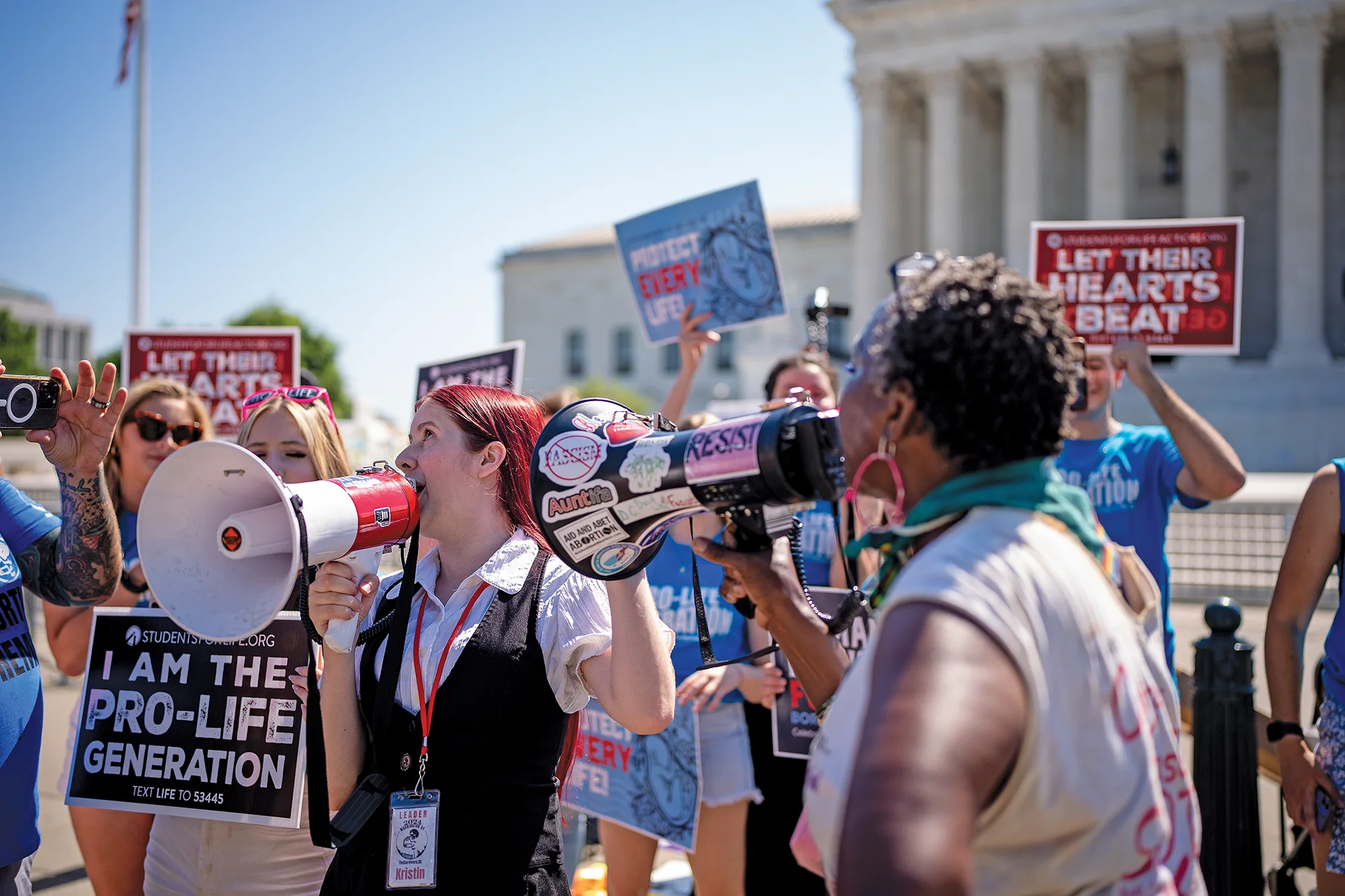
Linda Greenhouse ’68, who won a Pulitzer Prize for her New York Times reporting on the Court, wrote then that she couldn’t “remember a time when [followers of the Court were] so fixated on a single justice’s single vote”—or described it with such contradictory narratives. From the right, she wrote, Roberts was blasted as “a traitorous turncoat and a weakling to boot, unable to withstand liberal ‘bullying’”; from the left, as “a cynical manipulator who ‘wanted to maintain the Supreme Court as a playpen for anti-government sophistry.’”
But others praised Roberts’s courage for embodying the “virtue of compromise” through a Solomonic approach that he has used in other prominent cases, such as the Court’s historic 2022 ruling in Dobbs v. Jackson Women’s Health Organization, which ended the nationwide right to abortion. In that case, Roberts joined the Court’s five other conservatives in upholding a Mississippi statute that banned most abortions after 15 weeks of pregnancy, yet he did not vote with them to overturn the right. His divided vote separated him from the unprecedented decision of the other conservatives—and from the extraordinary, jointly signed dissent of the liberal justices—in a move of judicial self-protection that did nothing to protect the Court from a cascade of criticism.
Roberts’s efforts at judicial self-protection—usually called institutionalism—have often simply delayed conservative outcomes and haven’t altered the overall picture of his time as chief. From his arrival on the Court until now, his leadership, votes, and opinions have mainly helped move the law and the nation far to the right. In an analysis prepared for The New York Times and available in the Supreme Court Database, the political scientists Lee Epstein, Andrew Martin, and Kevin Quinn found that in major cases, the Roberts Court’s record is the most conservative of any Supreme Court in roughly a century.
A year after the abortion ruling, Greenhouse wrote: “To appreciate that transformation’s full dimension, consider the robust conservative wish list that greeted the new chief justice 18 years ago. Overturn Roe v. Wade. Reinterpret the Second Amendment to make private gun ownership a constitutional right. Eliminate race-based affirmative action in university admissions. Elevate the place of religion across the legal landscape. Curb the regulatory power of federal agencies.” She underscored that “every goal on the conservative wish list had been achieved. All of it. To miss that remarkable fact is to miss the story of the Roberts court.”
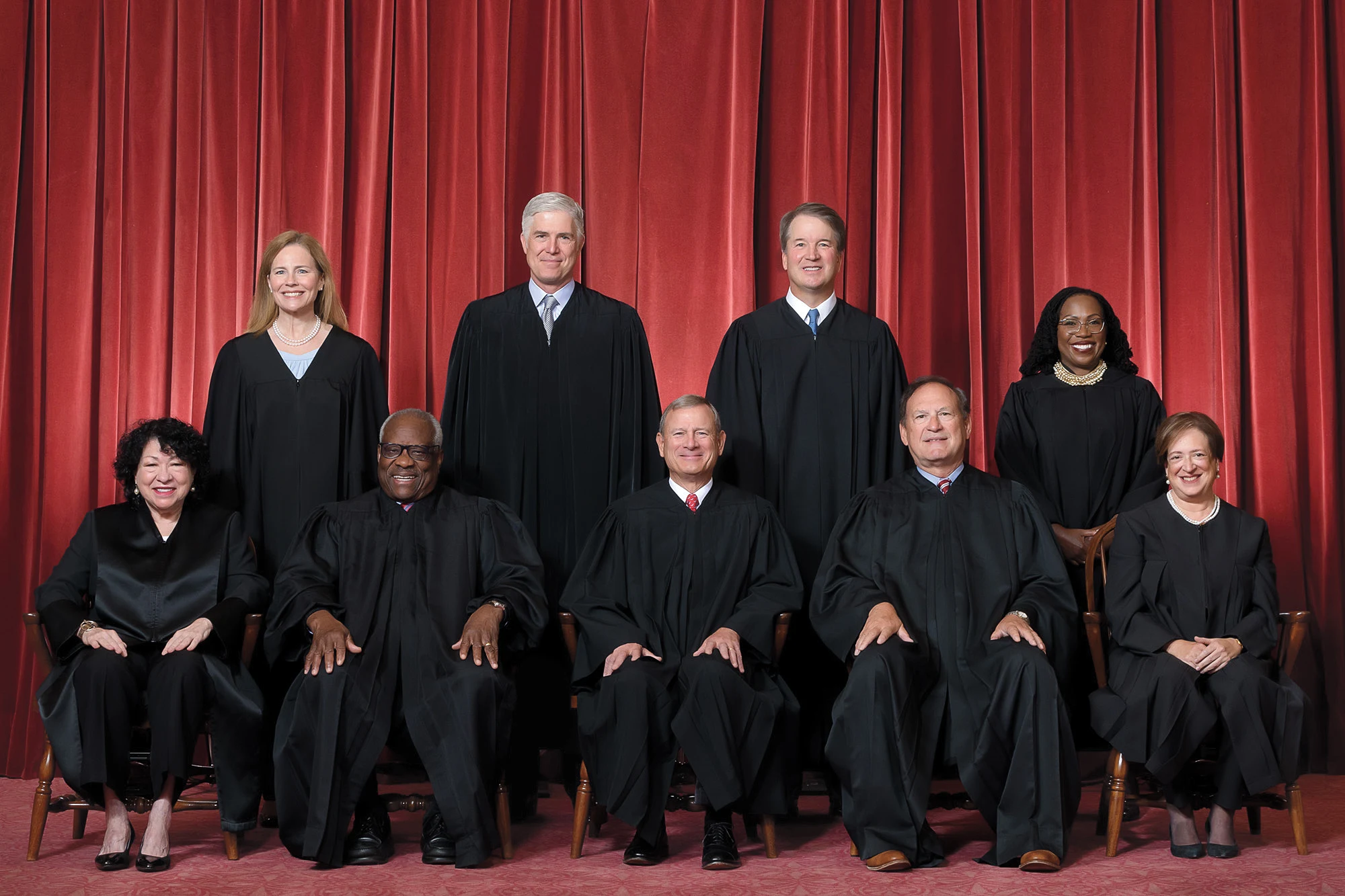
* * *
Ten months into his tenure as chief justice, Roberts had expressed his concern about the consequences of a Court seen as doing politics, not law, in a 2006 Atlantic interview with Jeffrey Rosen ’82, a George Washington University law professor and the president and CEO of the National Constitution Center. (The chief justice declined to comment for Harvard Magazine about that interview or about his tenure on the Court.)
Roberts spoke about the Supreme Court’s “credibility and legitimacy as an institution” and gave a straightforward definition of legitimacy: when people see the justices as Republicans and Democrats, they view the Court as political and polarized and they don’t respect or trust it. The chief justice said he was especially concerned about “the personalization of judicial politics” on the Court through the proliferation of concurring and dissenting opinions. “Instead of nine justices moving in nine separate directions,” Roberts told Rosen, “it would be good to have a commitment on the part of the Court to act as a Court, rather than being more concerned about the consistency and coherency of an individual judicial record.”
In the years Roberts has been chief, he has continued to present himself much as he did in that interview, though legal conservatism has changed in ways that don’t always align with views he has expressed in Court opinions and at public events. The legal scholar David Strauss ’73, J.D. ’78, commented to me, “He thinks, ‘Look, we built up these institutions over the centuries, including the Supreme Court, and there’s a lot in them that’s really worth protecting.’” But, Strauss went on, “Unlike conservatives of previous generations, today’s conservatives are uninterested in, and even dismissive of, judicial precedents and traditional ideas about the roles of courts and the executive branch.”
Opinion polls show that the public views the Court as partisan—and approves of it, as an institution, far less than in the past.
That could be part of the reason other justices have not always heeded Roberts’s desire for coherency. In decisions on the merits handed down by this summer in the most recent term, the justices voted unanimously in only 42 percent of the cases. In other cases, the extent of ideological and partisan differences was often sharp and extreme.
Opinion polls show that the public views the Court as partisan—and approves of it, as an institution, far less than in the past. Defenders of the Roberts Court emphasize that the judiciary is the most admired of the three branches, but while opinion about Congress has bounced up and down over the past half-century and opinion about the presidency has risen, then fallen, in that period, opinion about the Court has almost steadily descended.
Recent polls are especially eye-catching. In July 2025, a Gallup poll found that, for the first time in the past quarter-century, fewer than 40 percent of Americans overall approved of the Supreme Court’s performance: 11 percent of Democrats, compared to 75 percent of Republicans.
In June 2024, the National Opinion Research Center at the University of Chicago reported that most of the public lacks confidence in the Court’s rulings on abortion, voting and election rights, gun policy, and especially presidential power and immunity—hallmarks of the Roberts Court. In that poll, only 16 percent of Americans reported “a great deal of confidence” in the Court—29 percent of Republicans, 10 percent of Independents, and 7 percent of Democrats. Overall, 40 percent of Americans had “hardly any confidence at all.”
Most striking, considering Roberts’s desire to be a consensus-builder, is the way the public sees the individual justices as avatars of ideology. Seventy percent of Americans in that 2024 poll said justices are “more likely to try to shape the law to fit their own ideologies”—50 percent of Republicans, 74 percent of Independents, and 84 percent of Democrats. The numbers reflect the public grasp of the ambition of the Court’s conservative super-majority. As the legal historian Robert Post ’69, Ph.D. ’80, wrote, “The contemporary Court plainly and publicly aspires to reshape the landscape of American constitutional law.”
Regardless of the reasoning Roberts laid out in his opinion in Trump v. United States, the public was likely to view it through a partisan lens. That’s been even more true after the first eight months of the second Trump administration.
Relying on the Roberts Court’s broad interpretation of presidential power, Trump and his appointees have transformed the Justice Department into a protector of the president’s interests. They have used it to investigate, prosecute, and otherwise pressure individuals and institutions that have challenged Trump or his administration, in what is meant to be—and is widely seen as—a campaign of retribution.
In widespread roundups, they have used U.S. Immigration and Customs Enforcement against immigrants whom, without proof, they have deemed enemies of America. They have attempted to return immigrant children to dangerous home countries without due process, in the shadow of night, in efforts to circumvent federal courts. They have turned the FBI and the military into aggressive police forces based on declarations of public safety emergencies that lower courts have ruled don’t exist.
They have disparaged federal courts and defied a multitude of federal court rulings. The Washington Post reported in July that of 337 lawsuits filed by that date against the current Trump administration, federal judges ruled against the government 165 times, and “the administration is accused of defying or frustrating court oversight in 57 of those cases—almost 35 percent—“unprecedented for any presidential administration.” (A whistleblower last spring charged that, in one high-profile deportation case, leaders in Trump’s Justice Department advised attorneys that they might need to ignore court orders or mislead judges to achieve their aims—“telling the courts f*** you,” as one official allegedly said.)
Rewriting the nation’s story, Trump and his appointees have moved to alter the contents of displays in Smithsonian museums and national parks. They have used their power to make multifront attacks on a wide range of American institutions that hold the government accountable and provide safeguards against tyranny: accomplished private law firms; major media outlets; large foundations; and leading universities, Harvard most prominently. They have disrupted some of them to the point of upheaval and exerted unprecedented government influence over how they operate.
In late September, District Judge William Young ’62, LL.B. ’67, had scathing words for the Trump administration in a case about efforts to deport noncitizens who had engaged in pro-Palestinian speech. (One of the plaintiffs was Harvard’s chapter of the American Association of University Professors.) Young, 85, a Reagan appointee and a onetime chief counsel to a Massachusetts Republican governor, called the freedom of speech case “perhaps the most important ever to fall within the jurisdiction of this district court.”
Emergency cases have come to preoccupy the justices—and have reoriented how the Court shapes American law and life.
Young acknowledged “the rapidly changing nature of the Executive Branch under Article II of our Constitution and, while he is properly not now a defendant in these proceedings, the nature of our President himself.” He stated, unequivocally, that the Trump administration had misused the government’s “sweeping powers” to violate a First Amendment right that extends to noncitizens. And he said, in a footnote, that “this gambit has been accompanied by the Trump administration’s full-throated assault on the First Amendment across the board.”
Almost a century ago, a Supreme Court opinion by Justice Oliver Wendell Holmes Jr., A.B. 1861, LL.B. 1866, LL.D. 1895, defined “the principle of free thought” at the heart of American democracy, which is the foundation of American law protecting free speech and the free press from government suppression: “not free thought for those who agree with us, but freedom for the thought that we hate.” Trump and his administration seem to be taking dead aim at obliterating that principle and to be embracing its opposite.
* * *
When the Court hands down its final “merits” decisions each year—after considering legal briefs and listening to oral arguments, and after a lot of deliberation—that’s widely considered to be the end of the annual term, even though the official end is not until the start of the next term on the first Monday in October. An exclamation point invariably comes in the form of a summer blockbuster ruling, such as Trump v. United States in 2024.
This past June, the exclamation point was Trump v. CASA, an “emergency” case that arose from judicial injunctions against the executive order that Trump issued the day he was sworn in as president against the time-honored understanding of birthright citizenship.
A decision about an emergency case comes from the part of the Court’s work sometimes called “the shadow docket,” because it is much less transparent than the merits docket. Generally, those cases get decided quickly—without much briefing, without oral argument, and without an opinion explaining the decision. The orders are ostensibly provisional but, in many instances, they prove final.
Emergency cases until recently were rare in civil matters, used chiefly in criminal cases involving death sentences and imminent executions. The administration in office seldom brought them: the George W. Bush and Obama administrations together brought a total of eight in 16 years. The first Trump administration changed that norm, bringing 41, and the Biden administration brought 19. In its first 20 weeks, the second Trump administration brought 20. (By late September, it had brought 28.) Emergency cases have come to preoccupy the justices and take a lot of their attention. They have reoriented how the Court shapes American law and life.
CASA was only the fourth emergency case in more than half a century that the Court considered in oral argument. The case addressed the legality of the nationwide, or universal, injunction, which a trial judge in a single federal district court had the option of imposing throughout the United States against an executive order or other form of law.
Over the years, nationwide injunctions have been frustrating to administrations of both parties, which tend to argue they are imposed with partisanship. But while the Court had previous opportunities to address their lawfulness, it had declined to rule—until now, in a case that cut to the heart of American identity and rested on a legal precedent that went back more than a century and a quarter.
Section 1 of the Constitution’s Fourteenth Amendment says, “All persons born or naturalized in the United States, and subject to the jurisdiction thereof, are citizens of the United States and of the State wherein they reside.” In 1898, the Court affirmed birthright citizenship as “the ancient and fundamental rule of citizenship by birth within the territory”: if you’re born in America, unless you’re the child of a foreign diplomat, you’re an American.
Trump’s executive order—the opening salvo of the administration’s anti-immigrant campaign—says the 1898 ruling was mistaken for allowing citizenship in certain situations involving a parent who was not legally permitted to be present in the U.S.
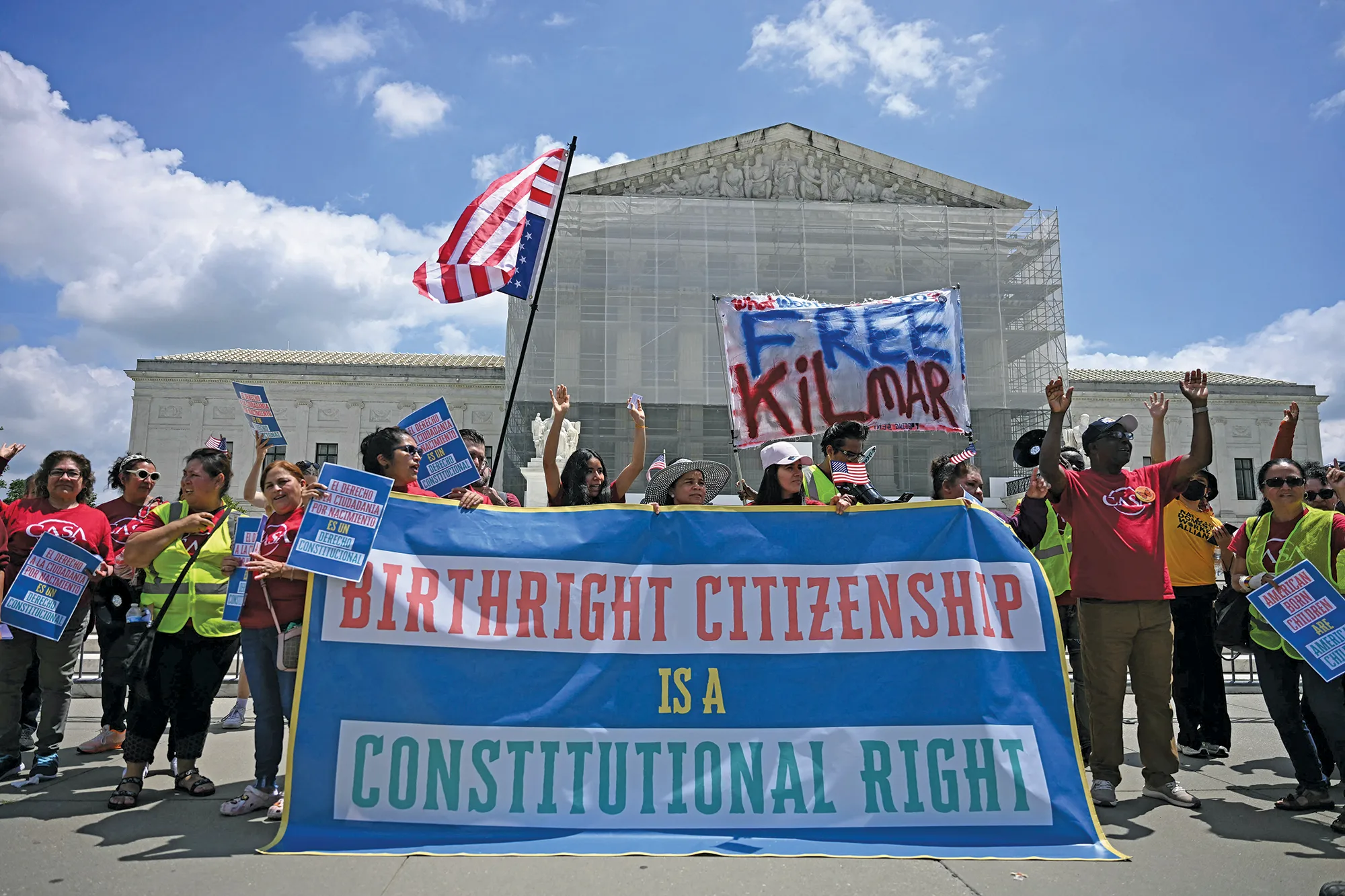
In its CASA decision, by a 6-3 vote along ideological and partisan lines, the Court severely limited the use of nationwide injunctions. The majority opinion by Justice Amy Coney Barrett did not grapple with the merits of the Trump administration’s argument about birthright citizenship; instead, it said this was a likely improper form of relief for anyone beyond the parties in that single lawsuit, and that a collective case should generally be handled through a class action suit.
In a concurring opinion, Justice Brett Kavanaugh encouraged the government and other parties to continue to file cases on the emergency docket and asserted that, in the sometimes-years-long interim between when an emergency case is filed and the Court rules on its constitutionality, the nation needs a unified answer on enforcement—and the Court should provide that answer.
Like the Trump decision, the CASA decision affected the balance of power among the three branches.
Injunctions issued in lower courts after the CASA ruling have kept the anti-birthright citizenship order from going into effect, because a patchwork approach to birthright citizenship—some states having it, others not—would cause confusion and burdens in states not allowing it. The administration’s slow response to those injunctions suggests it expects its attack on birthright citizenship to fail.
Still, like the Trump decision before it, the CASA decision affected the balance of power among the three branches—severely limiting a tool of lower federal court judges to block even blatantly unconstitutional policies of the government. It was built on the Roberts Court’s maximalist view of presidential power.
Other decisions the Court has recently made from the emergency docket show how much the Roberts Court has enabled Trump’s swift expansion of power. The decisions, often overturning lower court rulings, have had enormous, sometimes catastrophic, consequences: removing noncitizens to countries to which they had no ties; disqualifying transgender service members; firing probationary federal workers; firing members of the National Labor Relations and the Merit Systems Protection Boards; firing more than 1,000 workers at the Department of Education and dismantling the department; releasing reams of personal data to the Department of Government Efficiency, a White House initiative; allowing immigration raids in California, based on racial and ethnic profiling.
In September, the Court granted a Trump emergency request to withhold $4 billion in foreign aid that Congress had appropriated. The order, while noting it reflected a preliminary view, said the president’s power to conduct foreign affairs outweighs the potential harm to those designated to receive the aid.
Kagan, in a dissent supported by the other liberal justices, emphasized that the Trump emergency application raised novel issues about the relationship between the president and Congress. The Court should have waited to address them on the merits docket, she said, with the guidance of opinions from lower courts, full briefing, and oral argument.
In July, in a panel discussion at the National Constitution Center in Philadelphia, the legal scholar Stephen Vladeck, who in 2023 published The Shadow Docket: How the Supreme Court Uses Stealth Rulings to Amass Power and Undermine the Republic, had explained the logic behind the Roberts Court’s decisions: Emergency relief is based on the view that the party requesting it is likely to win on the merits. Until that victory, it will suffer irreparable harm without the relief. The government suffers irreparable harm whenever one of its laws, including an executive order, is blocked.
But, Kagan pointed out in her dissent about the refusal to pay foreign aid, the administration had not shown it was likely to win on the merits. It had not shown it would suffer irreparable harm without the relief granted in the order. It had not “met our standard for emergency relief.”
In each recent emergency decision for the Trump administration, the order in question, once in effect, did irreparable harm to some or all of its targets. Those rulings, Lawrence Hurley reported on NBC News in September, have left some lower court judges appointed by Republican and Democratic presidents, who worked “painstakingly” to apply the law as it existed and were overturned, feeling frustrated and betrayed—undermined and abandoned by the super-majority of the Supreme Court. “It is inexcusable,” one judge told Hurley about those justices. “They don’t have our backs.”
In a dissent from the CASA ruling, Justice Sotomayor echoed her complaints about the Trump ruling a year earlier: “The Court’s decision is nothing less than an open invitation for the Government to bypass the Constitution. The Executive Branch can now enforce policies that flout settled law and violate countless individuals’ constitutional rights, and the federal courts will be hamstrung to stop its actions fully. Until the day that every affected person manages to become party to a lawsuit and secures for himself injunctive relief, the Government may act lawlessly indefinitely.”
* * *
Throughout his two decades as chief justice, Roberts has looked to historical role models for guidance and comparison—from the clear-eyed approach to justice embodied by his early mentor, Henry Friendly, to the human qualities of his former boss and predecessor, William Rehnquist, whom he called “an extraordinarily good and decent man.” Prominently, Roberts has also cited the legacy of John Marshall, the legendary chief justice from 1801 to 1835, as a practitioner of principled and pragmatic jurisprudence.
But the Marshall-Roberts comparison isn’t entirely apt. Marshall was aligned with a political regime out of power—he was a Federalist, at a time when the nation was divided between Federalists, who favored a strong national government and a commercial economy, and anti-Federalists, who favored a limited national government and an agrarian economy. A month after he was sworn in as chief justice, Marshall swore in the anti-Federalist Thomas Jefferson as president—and spent much of his almost 35 years on the bench trying to resist or reckon with a contrary regime in power.
“The Court’s decision is nothing less than an open invitation for the Government to bypass the Constitution.”
—Justice Sonia Sotomayor, dissenting in the CASA case
Roberts is positioned more like Marshall’s successor, Roger Taney, who was chosen by, and generally on the same side as, the regime in power during his 28 years as chief.
Taney has been ranked among the country’s great justices by professors of law, history, and political science, as the historian Walter Ehrlich wrote in the Oxford Companion to the Supreme Court of the United States. In his long tenure, Ehrlich wrote, Taney “preserved and refined the main lines of Marshall’s constitutional law, opened economic opportunities for many Americans, and retained a strong national power redefined to accommodate a judicial dual sovereignty” with that of each state.
But that’s not how most people know of him. Taney is infamous for inflaming America’s bloody division over slavery and for making the Civil War inevitable. As Ehrlich wrote, “Even though he saw nothing positive about the institution of slavery itself, Taney withal was a southern gentleman imbued with southern values, and here was an opportunity to settle the issue.”
In the Dred Scott case of 1857, Ehrlich summarized, the “southern and proslavery” majority of the Court, with Taney writing its notorious opinion, ruled that Black people couldn’t be American citizens; that the Constitution regarded slaves as property; and that each state where slavery was lawful could decide if an emancipated person could be made a slave again. The decision and the opinion made Taney a pariah and gutted the authority of the Court.
In his confirmation hearing, Roberts called that decision “perhaps the most egregious example of judicial activism in our history,” with “disastrous consequences.” After the ruling in the Trump case, though, some progressive commentators reacted by declaring that Roberts is as contemptible as Taney, based on a comparison of the Dred Scott and Trump decisions and their arguably similar shattering of the American republic. The commentary illustrated deep agitation about Trump and his dominance. It was part of what Roberts called “the personalization of judicial politics,” whose harm to the Court he worried about early in his tenure.
A fatalistic way to view Roberts’s intentions has taken hold in the first year of the second Trump term. Some legal observers contend that the conservative majority has exercised prudence in many of those emergency rulings, by engaging in Roberts’s method of judicial self-protection. By issuing a procedural decision in favor of the administration, the reasoning goes, the majority put off a difficult reckoning. It avoided the risk of issuing a substantive order that the president would defy, creating a full-blown constitutional crisis. As the legal scholar William Baude commented in The New York Times in July, “Even if you wanted the court to maximally stop the Trump administration, surely it would need to pick and choose its spots carefully. There’s just too much lawlessness to do otherwise.”
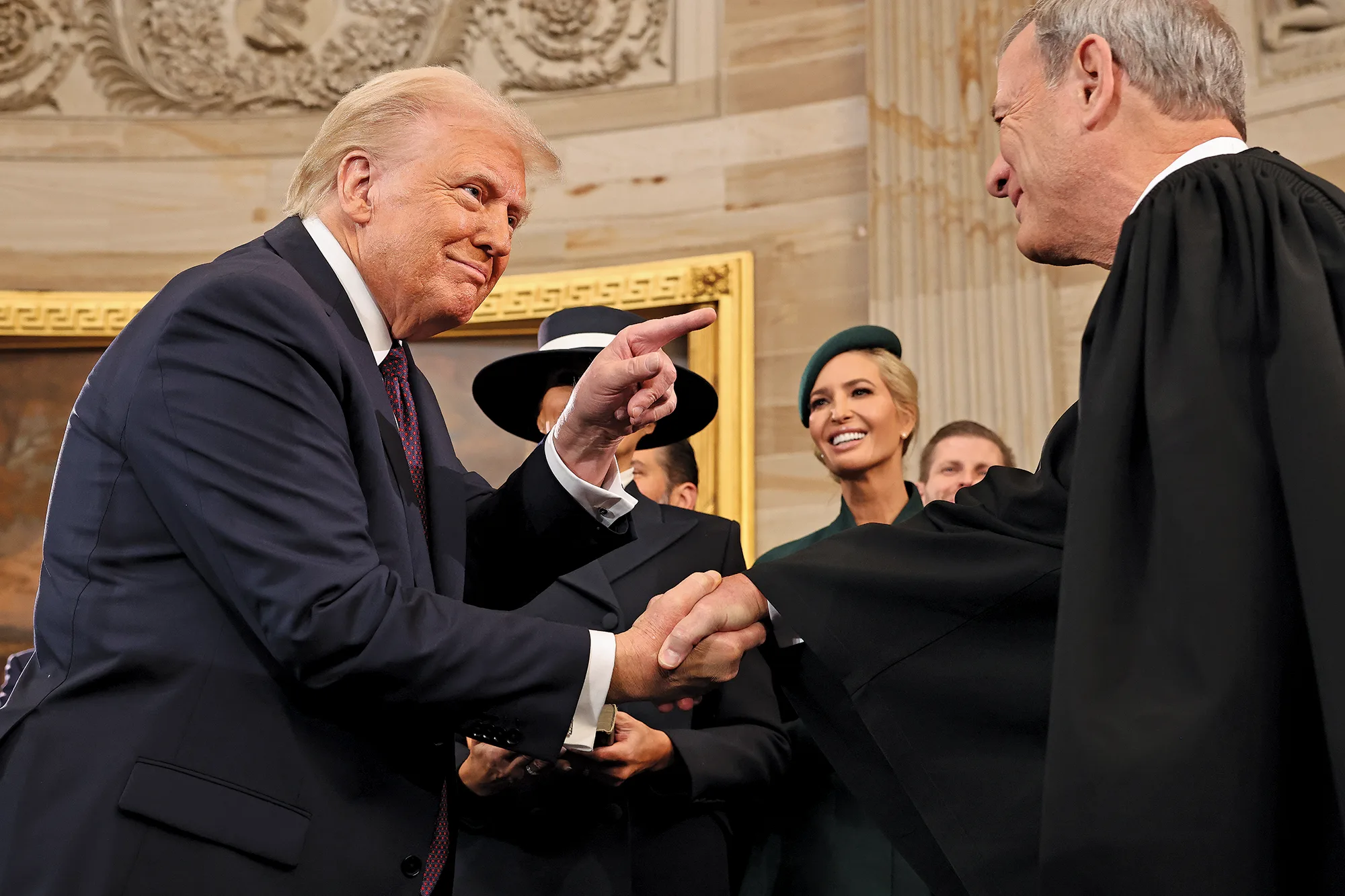
Outside the circle of professional Court watchers, though, the self-protection, if that’s what it has been, looks like partisan support for the Trump administration. It looks as if the Court is forsaking its checking function in the system of checks and balances and using its power in service of the Trump agenda. After the CASA ruling, many judicial observers remarked on how, through its emergency docket, the Court was often ruling for the Trump administration without explaining why—rule by edict in place of rule by law.
The legal scholar Rogers Smith wrote in The Annals of the American Academy of Political and Social Science in June, “In a country deeply divided over constitutional conservatism, Roberts’s tenure as chief justice has led to the opposite of what he has said he seeks to achieve. The American public now respects the Court less than ever and sees it as more political than ever.”
Twenty years ago, in his speech against Roberts’s confirmation, then-Senator Obama recounted a conversation with Roberts from the day before. Roberts, Obama recalled, had told him that “he doesn’t like bullies and has always viewed the law as a way of evening out the playing field between the strong and the weak.” Knowing that his “nay” vote wouldn’t halt Roberts’s confirmation, Obama offered a wish for the future: “Given the gravity of the position to which he will undoubtedly ascend,” he emphasized, “I hope that his jurisprudence is one that stands up to the bullies of all ideological stripes.”
Trump, to many, personifies the bully Obama warned about. His assault on democracy has tested Roberts’s institutionalism in ways the chief justice seems not to have anticipated, or not to have wanted—or been able to lead—the Court to constrain.
As a singular American figure, the 47th president might have a singular effect on Roberts’s legacy. That’s why the Trump opinion looms so large. It would be a tragedy for Roberts if his long tenure as chief justice were reduced to that single ruling and opinion because the portents of doom in the Sotomayor dissent prove accurate in the extreme—and turn what Roberts meant as the solution to a problem of constitutional governance into a license for autocracy.
It would also be a tragedy for the Supreme Court and for the United States. This is a moment in the nation’s history when the need for a strong and respected Court is acute. But the Trump ruling seemed to embolden the president to further stretch the bounds of the Constitution—and each new decision in Trump’s favor erodes public trust that the Court will constrain him.
Ensuring that the executive respects the rule of law is the ultimate test Roberts may face. Suppose the Court orders the president to end a policy because it violates the law—a policy Trump deems essential to his cause. If the Trump decision and the Court’s loss of public legitimacy lead the president to think he has the power to disobey that order, what safeguard against authoritarianism will be left?
In a landmark decision almost 75 years ago—striking down an effort by President Harry Truman to seize and operate most of the nation’s steel mills—Justice Robert Jackson wrote famous words in a concurring opinion about the Supreme Court’s duty to constrain a president who disobeys the law: “With all its defects, delays and inconveniences, men have discovered no technique for long preserving free government except that the Executive be under the law, and that the law be made by parliamentary deliberations. Such institutions may be destined to pass away. But it is the duty of the Court to be last, not first, to give them up.”








